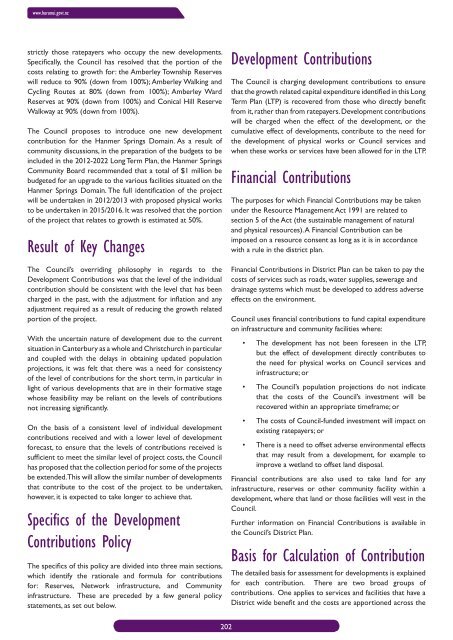Long Term Community Plan 2012-2022 - Hurunui District Council
Long Term Community Plan 2012-2022 - Hurunui District Council
Long Term Community Plan 2012-2022 - Hurunui District Council
You also want an ePaper? Increase the reach of your titles
YUMPU automatically turns print PDFs into web optimized ePapers that Google loves.
www.hurunui.govt.nz<br />
strictly those ratepayers who occupy the new developments.<br />
Specifically, the <strong>Council</strong> has resolved that the portion of the<br />
costs relating to growth for: the Amberley Township Reserves<br />
will reduce to 90% (down from 100%); Amberley Walking and<br />
Cycling Routes at 80% (down from 100%); Amberley Ward<br />
Reserves at 90% (down from 100%) and Conical Hill Reserve<br />
Walkway at 90% (down from 100%).<br />
The <strong>Council</strong> proposes to introduce one new development<br />
contribution for the Hanmer Springs Domain. As a result of<br />
community discussions, in the preparation of the budgets to be<br />
included in the <strong>2012</strong>-<strong>2022</strong> <strong>Long</strong> <strong>Term</strong> <strong>Plan</strong>, the Hanmer Springs<br />
<strong>Community</strong> Board recommended that a total of $1 million be<br />
budgeted for an upgrade to the various facilities situated on the<br />
Hanmer Springs Domain. The full identification of the project<br />
will be undertaken in <strong>2012</strong>/2013 with proposed physical works<br />
to be undertaken in 2015/2016. It was resolved that the portion<br />
of the project that relates to growth is estimated at 50%.<br />
Result of Key Changes<br />
The <strong>Council</strong>’s overriding philosophy in regards to the<br />
Development Contributions was that the level of the individual<br />
contribution should be consistent with the level that has been<br />
charged in the past, with the adjustment for inflation and any<br />
adjustment required as a result of reducing the growth related<br />
portion of the project.<br />
With the uncertain nature of development due to the current<br />
situation in Canterbury as a whole and Christchurch in particular<br />
and coupled with the delays in obtaining updated population<br />
projections, it was felt that there was a need for consistency<br />
of the level of contributions for the short term, in particular in<br />
light of various developments that are in their formative stage<br />
whose feasibility may be reliant on the levels of contributions<br />
not increasing significantly.<br />
On the basis of a consistent level of individual development<br />
contributions received and with a lower level of development<br />
forecast, to ensure that the levels of contributions received is<br />
sufficient to meet the similar level of project costs, the <strong>Council</strong><br />
has proposed that the collection period for some of the projects<br />
be extended. This will allow the similar number of developments<br />
that contribute to the cost of the project to be undertaken,<br />
however, it is expected to take longer to achieve that.<br />
Specifics of the Development<br />
Contributions Policy<br />
The specifics of this policy are divided into three main sections,<br />
which identify the rationale and formula for contributions<br />
for: Reserves, Network infrastructure, and <strong>Community</strong><br />
infrastructure. These are preceded by a few general policy<br />
statements, as set out below.<br />
Development Contributions<br />
The <strong>Council</strong> is charging development contributions to ensure<br />
that the growth related capital expenditure identified in this <strong>Long</strong><br />
<strong>Term</strong> <strong>Plan</strong> (LTP) is recovered from those who directly benefit<br />
from it, rather than from ratepayers. Development contributions<br />
will be charged when the effect of the development, or the<br />
cumulative effect of developments, contribute to the need for<br />
the development of physical works or <strong>Council</strong> services and<br />
when these works or services have been allowed for in the LTP.<br />
Financial Contributions<br />
The purposes for which Financial Contributions may be taken<br />
under the Resource Management Act 1991 are related to<br />
section 5 of the Act (the sustainable management of natural<br />
and physical resources). A Financial Contribution can be<br />
imposed on a resource consent as long as it is in accordance<br />
with a rule in the district plan.<br />
Financial Contributions in <strong>District</strong> <strong>Plan</strong> can be taken to pay the<br />
costs of services such as roads, water supplies, sewerage and<br />
drainage systems which must be developed to address adverse<br />
effects on the environment.<br />
<strong>Council</strong> uses financial contributions to fund capital expenditure<br />
on infrastructure and community facilities where:<br />
• The development has not been foreseen in the LTP,<br />
but the effect of development directly contributes to<br />
the need for physical works on <strong>Council</strong> services and<br />
infrastructure; or<br />
• The <strong>Council</strong>’s population projections do not indicate<br />
that the costs of the <strong>Council</strong>’s investment will be<br />
recovered within an appropriate timeframe; or<br />
• The costs of <strong>Council</strong>-funded investment will impact on<br />
existing ratepayers; or<br />
• There is a need to offset adverse environmental effects<br />
that may result from a development, for example to<br />
improve a wetland to offset land disposal.<br />
Financial contributions are also used to take land for any<br />
infrastructure, reserves or other community facility within a<br />
development, where that land or those facilities will vest in the<br />
<strong>Council</strong>.<br />
Further information on Financial Contributions is available in<br />
the <strong>Council</strong>’s <strong>District</strong> <strong>Plan</strong>.<br />
Basis for Calculation of Contribution<br />
The detailed basis for assessment for developments is explained<br />
for each contribution. There are two broad groups of<br />
contributions. One applies to services and facilities that have a<br />
<strong>District</strong> wide benefit and the costs are apportioned across the<br />
202

















